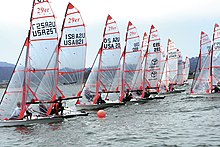29er dinghy
| Notation | |
|---|---|
|
|
|
| Boat dimensions | |
| Length above : | 4.45 m |
| Width above sea level : | 1.77 m |
| Weight (ready to sail): | 90 kg |
| Sail area | |
| Sail area close to the wind : | 12.5 m² |
| Mainsail : | 8.8 m² |
| Jib : | 3.7 m² |
| Gennaker : | 17 m² |
| Others | |
| Rigging type: | Sloop |
| Yardstick number : | 94 |
| Class : | one design |
The 29er is a skiff for adults and teenagers. The boat is a one design boat, which means that all boats are identical, from the sail to the hull.
history
Constructed by the Australian Julian Bethwaite , the first examples of the 29er were built in 1998 in a strip construction. It was developed as a smaller version of the Olympic 49er to offer young sailors a suitable boat for beginners. In 2001 the 29er was selected by the ISAF as a two-handed boat for the youth world championships, which took place in Canada in 2002 . The 29er is now manufactured under license in England , Canada, Argentina , New Zealand , South Africa and Australia . The 29er has been a DSV youth championship class in Germany since 2005 and was allowed to host its first international German championship in 2008, as more than 60 teams are listed in the ranking. Many clubs are therefore replacing their 420 dinghies or pirates with the modern 29er. In 2008, the ISAF replaced the 420 with the 29 as a boat class at the ISAF Youth Worlds .
hull
The fuselage is made of glass fiber reinforced plastic (GRP) in full sandwich construction with a double floor. The hulls are built in Europe by Ovingtonboats.
Rigging, rigging, sails
The mast is made of aluminum-CFRP composite material and can be divided into three parts . The jib is self-turning , which means that once the jib has been set for the cross , it no longer needs to be operated when turning , but changes its position automatically for the new course. In addition, the boat has a fully battened mainsail , which is driven by hand, as well as a gennaker for half-wind to space sheet courses. The sails are made from foil material (like windsurfing). Only the gennaker is made of light fabric like other spinnakers .
Sailing in the 29er
On the 29er only the bow is in the trapeze , while the helmsman is sitting in the riding harness . Due to its shape, the 29er is more difficult to hold upright compared to other dinghies. The ideal weight of the crew is between 100 and 145 kg, depending on the mass, the team has an advantage in high or low wind.
The 29er was specially designed for beginners in (skiff) sailing. Compared to the pirate or the 420 dinghy , it is sometimes more difficult to sail, but more agile and faster - the record is now over 25 knots. The gennaker system and the self-turning jib make sailing easier.
On closewind courses, the boat is held upright by the bow by weight trimming and using the trapeze; the helmsman steers the boat. The mainsheet guide allows the bow on the cross to operate the mainsail so that it can hold the boat upright. On room sheet and half wind courses, the bow man operates the gennaker and the helmsman takes over the mainsail.
29erXX
The 29erXX consists of the same hull as the classic 29er and differs in that it has a larger rig with two trapezoids. As with the classic 29er rig, foil sails are used, but the gennaker starts at the top of the mast. The 29erXX was originally designed as an Olympic women's boot, more or less a 49er for women.

